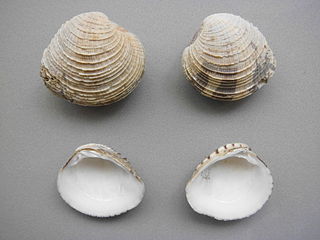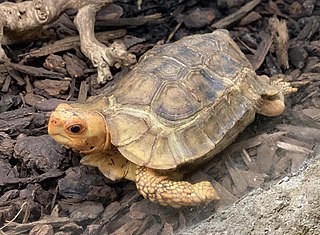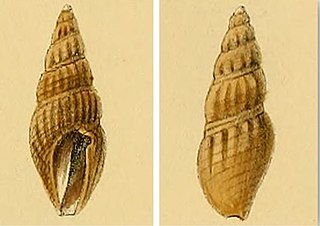
Callista chione, the smooth clam, is a rather large, temperate, marine, bivalve mollusc that inhabits sandy bottoms or with small pebbles in clean waters down to about 200 m from the British Isles to the Mediterranean. The shell can reach up to about 110 mm Ø, its outer side is smooth and ranges from light greenish creamy colour to medium brown, probably varies to match the background; the interior is white to soft pink. The concentric and radial growth lines are easily seen. Callista chione is edible, different dishes are prepared throughout the Mediterranean in Spain, Italy, France, the Balkan and the Maghreb countries.

Chione cancellata, is a species of medium-sized saltwater clam, a marine bivalve mollusc in the family Veneridae, the venus clams.

Chione is a genus of American tropical marine bivalve molluscs, in the family Veneridae.

The forest hinge-back tortoise, also known commonly as the serrated hinge-back tortoise or Schweigger's tortoise, is a species of tortoise in the family Testudinidae. The species is indigenous to the tropical forests and marshes of central and western Africa.
Omphalotropis erosa is a species of minute salt marsh snail with an operculum, a terrestrial gastropod mollusk, or micromollusk, in the family Assimineidae. The species is endemic to Guam.
Hopea erosa is a species of plant in the family Dipterocarpaceae. It is endemic to the southern end of the Western Ghats in India.

Asclepias erosa is a species of milkweed known commonly as desert milkweed. It is native to southern California, Arizona, and northern Baja California, where it is most abundant in the desert regions.

Anomis erosa, the yellow scallop moth or abutilon moth, is a moth of the family Erebidae. The species was first described by Jacob Hübner in 1821. It is found in south-eastern North America. It is mostly a southern species, but migrants reach Manitoba, Quebec and Maine.

Rhodopetoma erosa is a species of sea snail, a marine gastropod mollusk in the family Pseudomelatomidae.

Rhodopetoma is a genus of sea snails, marine gastropod mollusks in the family Pseudomelatomidae.

Coralliophila erosa is a species of sea snail, a marine gastropod mollusk in the family Muricidae, the murex snails or rock snails.

Naria erosa, common name the gnawed or eroded cowry, is a species of sea snail, a cowry, a marine gastropod mollusk in the family Cypraeidae, the cowries.
Chione is a monotypic genus of flowering plants in the family Rubiaceae containing the single species Chione venosa. It is native to the neotropics, occurring in most of Mexico, and throughout Central America, the Caribbean, Colombia, Ecuador, and Peru. It is typically a tree growing 10 to 20 meters tall. In harsh habitats, it may be dwarfed and shrubby. It has no known economic use.

Hamelieae is a tribe of flowering plants in the family Rubiaceae and contains about 171 species in 6 genera. Its representatives are found in tropical and subtropical America. The sister tribe Hillieae is sometimes here included.

The pitted stonefish, also known as the Pacific monkey-fish, is a species of venomous ray-finned fish, a stonefish be longing to the subfamily Synanceiinae of the family Scorpaenidae, the scorpionfishes and their relatives. It is the only species in the monotypic genus Erosa and is found in the eastern Indian Ocean and the western Pacific Ocean.
Punctapinella chione is a species of moth of the family Tortricidae. It is found in Pastaza Province, Ecuador.

Zamia erosa is a species of cycad native to the Caribbean islands of Jamaica, Cuba, and Puerto Rico, described by Orator Fuller Cook and Guy N. Collins in 1903. The species formerly known as Z. amblyphyllidia was determined in 2010 to be the same species as Z. erosa. It is listed as vulnerable by the IUCN Red List.
Tegrodera erosa is a species of blister beetle in the family Meloidae. It is found from California south to Sinaloa.

Chione elevata, the Florida cross barred venus, is a species of bivalve in the family Veneridae often confused for another species, Chione cancellata with a more southern distribution.













